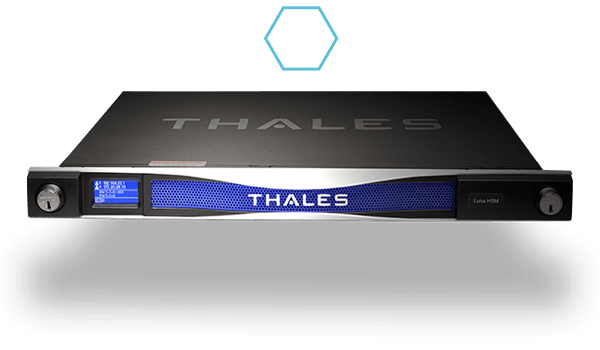TalkingTrust with Thales and Red Hat - Securing Containers and DevOps
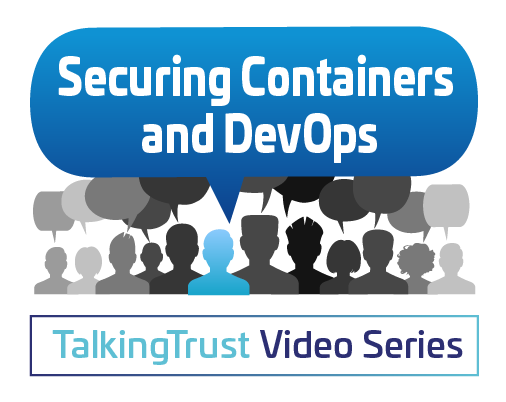 Containers and DevOps are being embraced as critical elements of enterprise digital transformation strategies, as this new paradigm provides development teams with an efficient way to build and deploy applications across hybrid cloud environments at scale. Red Hat and Thales have partnered to enable the benefits of DevSecOps to ensure code runs securely and data can be protected effectively. Thales and Red Hat discuss in this video how to enable a secure and scalable DevOps platform to deploy new services efficiently.
Containers and DevOps are being embraced as critical elements of enterprise digital transformation strategies, as this new paradigm provides development teams with an efficient way to build and deploy applications across hybrid cloud environments at scale. Red Hat and Thales have partnered to enable the benefits of DevSecOps to ensure code runs securely and data can be protected effectively. Thales and Red Hat discuss in this video how to enable a secure and scalable DevOps platform to deploy new services efficiently.
Join Red Hat and Thales in a discussion about how Containers and DevOps are critical elements of enterprise digital transformation, and how they have partnered to ensure code runs securely and data can be protected effectively.
Speakers:
David Madden, Director of Business Development at Thales
Cameron Skidmore, Associate Solutions Architect at Red Hat
Review all integrations and supporting documents for Thales with Red Hat.
Thales Technology Partner: cpl.thalesgroup.com/partners/redhat
Partner website: www.redhat.com

Resources:
Video Transcript
TalkingTrust Series – Thales and Red Hat - Securing Containers
00:10 Hello.
00:11 My name is David Madden from Thales and
00:14 I'm here today to talk about securing
00:16 containers and DevOps.
00:17 We're glad to have Cameron Skidmore,
00:20 Associate Solutions Architect at Red Hat
00:22 with us,
00:22 who's an industry expert in containers
00:24 and open source,
00:26 to help us understand the critical and
00:28 emerging market. Microservices and
00:30 containerized architectures are being
00:32 embraced as a critical element of
00:34 enterprise digital transformation,
00:36 as a container platform offers
00:38 developers teams an efficient way to
00:40 build and deploy
00:41 apps across hybrid cloud environments
00:44 really at scale.
00:45 However, what is missing typically is a
00:47 security element.
00:49 Red Hat and Thales can help ensure
00:51 code runs securely
00:53 and data can be protected effectively. So
00:56 today
00:56 as a result of all of this we're going
00:58 to talk a little bit more about how Red
01:00 Hat and Thales
01:00 can enable a secure and scalable DevOps
01:04 platform to
01:05 deploy services. So with that let's get
01:07 started
01:08 with a short history and background on
01:10 DevOps containerization.
01:11 Cameron, can you share a few details with
01:14 us so we can better understand?
01:16 Sure Dave, I'd love to. So this idea of
01:19 DevOps I think it really
01:21 came out of a need to solve a problem
01:23 and that problem was that code just
01:25 wasn't getting
01:26 built and even deployed quick enough
01:30 and that there was this massive
01:31 inefficiency in the process.
01:33 For me the best way I know how to kind
01:35 of describe this within a metaphor
01:37 is it's like a relay race right with
01:39 batons. And, you've got one runner
01:42 running up to hand it off to the next
01:43 runner but of course the other runner
01:45 starts running before they get there
01:47 so both are kind of working together in
01:49 that moment and there's not this hard
01:50 stop,
01:51 where the person has to from nothing
01:53 start with the baton again.
01:55 I think it's a similar kind of idea with
01:58 DevOps because
01:59 you want there not to be this hard
02:02 demarcation point
02:03 where the Dev team then has to throw
02:05 code over to the Ops team
02:07 and it just kind of creates this massive
02:09 amount of
02:11 inefficiency in the process right? Yeah
02:15 and I think that you know this is
02:16 something people have been working on
02:18 for a while. DevOps isn't really
02:19 a new idea at this point but there's a
02:21 lot of let's say technological
02:23 innovation going on right now, right?
02:25 There's a whole lot of stuff in the
02:26 field of automation
02:28 in cloud technology and I think
02:31 you and I talked about this before, but
02:33 DevOps is really a function of
02:35 the cultural adoption of DevOps. But then
02:38 you got to combine that with all this
02:39 technology
02:40 and the primary technology being adopted
02:43 to drive that
02:44 is really the automation. And that's kind
02:47 of what
02:47 you know add those two together and
02:49 you're gonna end up getting
02:51 the amount of success that your teams
02:53 are looking for in DevOps.
02:56 Makes sense. So how are modern
02:58 organizations then leveraging
03:00 open source DevOps and containers as a
03:02 core part of these digital
03:04 transformation plans? Sure that's a great
03:07 question
03:08 and when you're talking about the
03:10 digital transformation or you're talking
03:12 about things like IoT
03:13 or cloud, fundamentally more and more
03:16 what I think that
03:17 ends up being is a conversation around
03:20 container technology
03:21 right? Because all these are kind of
03:23 converging within that and the container
03:25 technology
03:26 is different than legacy infrastructure
03:29 because,
03:29 and we were talking about this before,
03:31 but it was built
03:33 with DevOps already in mind. Right.
03:35 We can
03:36 see that and how they put together
03:38 these solutions and these technologies.
03:40 It's not where you're having to, you know,
03:42 shoehorn the teams to work together in
03:44 ways that
03:44 the environment was never designed to.
03:46 It's more about
03:48 from jump, you can see oh it's the you
03:50 know, the Devs teams are flowing really
03:52 well into the Ops team
03:54 and it's just kind of a natural
03:56 progression from that.
03:58 And so I read how we talk about the
04:00 digital transformation a lot
04:02 and DevOps is really key to digital
04:04 transformation
04:05 because fundamentally with digital
04:08 transformation
04:09 that's something where the
04:12 the company itself right is trying to
04:15 reinvent their processes, their business
04:17 processes. They're trying to
04:19 put technological innovation first and
04:21 foremost
04:22 and I think at first when people hear
04:25 digital transformation, they may think
04:27 okay we're going to transform digitally.
04:28 We're going to move into the
04:30 the cloud space. We're going to adopt
04:33 all this technology
04:34 but it's not just one big sprint, it's
04:36 more of a marathon.
04:38 Right. You're going to have
04:39 to constantly
04:41 get your developers what they need and
04:42 keep the pace up over
04:44 the next year and decade even.
04:47 And there's going to be a huge
04:48 advantage for companies that are able to
04:49 do that and
04:50 leverage this kind of technology. Makes
04:53 sense. And so it sounds like
04:55 you know development, IT, operations
04:58 they're going you know from a service
05:01 provider approach to almost a core part
05:03 of the whole digital value creation
05:05 process.
05:06 So, this is really now a core asset of
05:08 any business in a digital economy
05:10 would you agree Cameron? I certainly
05:12 would agree,
05:13 and I think that also a
05:16 big aspect of maybe
05:20 the perceived risk going into this new
05:22 paradigm especially with all this new
05:24 technology,
05:25 is that there's this hesitation
05:29 on the part of, well maybe I don't really
05:31 know everything about
05:32 Kubernetes or I don't know everything
05:34 about
05:34 how security works in Kubernetes.
05:37 We found in our
05:38 research is that a big blocker for this
05:40 digital transformation
05:41 is mainly those two things.
05:45 Which is why I think it's really
05:46 important for companies like Thales and
05:48 Red Hat to work together
05:49 because helping meet people where their
05:53 IT skills are and you know implementing
05:56 top tier enterprise ready
05:58 security on top of it, I think that we
06:00 can really
06:01 lower the barrier to entry for digital
06:03 transformation together.
06:07 Makes sense. So in terms of
06:10 security
06:11 it's like a platform
06:13 almost and then leveraging
06:15 Red Hat really drives things as a
06:17 platform where
06:18 you can you can take these elements and
06:21 apply them in
06:22 across your organization if you will, so
06:24 it enables things.
06:26 Obviously if it's not there
06:28 you've got a considerable risk
06:30 from both your platform running
06:32 smoothly,
06:33 efficiently as well as making
06:35 sure things you're not
06:37 missing an element as you roll from
06:40 development to
06:41 production. So how would you
06:44 architect this with Red Hat open
06:47 shift,
06:48 and how do you implement it across
06:49 containers? Can you describe
06:51 a little more detail for us? Yeah
06:53 absolutely, I can give a quick flyby of
06:55 the architecture behind OpenShift.
06:57 So as it always does it really starts
07:00 with the OS.
07:01 Our goal with the OS that all
07:03 this is going to be running on
07:05 is to give you the ability to draw from
07:08 any kind of platform right,
07:09 if it's your own personal data center,
07:12 if it's a cloud environment, we want
07:16 it to feel all like it's cut from the
07:18 same piece of cloth,
07:19 right? Because that's going to also help
07:21 this cooperation in DevOps without
07:23 everybody having to
07:25 work with different types of you know
07:28 starting points and core OS
07:30 How we've been able to do that
07:33 and core OS
07:34 for the points of security here, it's
07:36 it's a very
07:37 special operating system because for one
07:39 it can scale of course but
07:41 for two it's designed with the smallest
07:44 amount of surface area for attack
07:45 possible.
07:46 And once it's built it can't really be
07:49 altered. So it's unalterable as an OS,
07:51 makes it very secure from a security
07:53 point of view.
07:56 The only other the really quick main
07:58 point that I also want to make
08:00 is that Kubernetes is OpenShift. I
08:03 think sometimes people hear OpenShift
08:04 and they're like OpenShift versus
08:06 Kubernetes, but really OpenShift
08:08 is built on top of Kubernetes.
08:10 That's really the movement
08:12 behind it we just have a lot of other
08:14 things to again going back to what we
08:16 were saying before,
08:17 perceived lack of talent on
08:21 the part of
08:21 certain companies wanting to adopt this
08:23 technology that's why we built OpenShift.
08:25 We
08:26 make it easier to install wherever you
08:27 want to install it.
08:29 We make it easy whether it's in a
08:31 cloud or an on-premise environment.
08:33 Auto scaling is determined through
08:37 the actual OpenShift GUI, so it's a lot
08:39 simpler and a lot more approachable.
08:42 We even have one-click updates as
08:45 well, so you're not constantly
08:47 tasking your administrators with the
08:49 kind of overhead
08:50 that might come with administering a
08:52 Kubernetes vanilla
08:56 environment all by themselves.
08:58 That's another big part of it.
09:00 We also have services that exist like
09:03 code ready workspaces
09:04 and Istio service mesh and all these
09:07 other things to kind of help round out
09:09 the sharper edges of Kubernetes
09:10 environment that you might have just on
09:12 its own.
09:13 I think that's an important point as
09:14 well. We kind of lay that out here in the
09:17 in the in the top section with the
09:19 application services and stuff,
09:21 but yeah, Kubernetes effectively
09:24 deployable in the enterprise by
09:26 providing all these
09:28 you know Red Hat value ads beyond just
09:30 the core OS.
09:31 Absolutely, and that's really
09:34 why people have kind of gravitated
09:37 toward OpenShift and we've been
09:39 working on this offering in parallel
09:41 with Kubernetes for five years now. We've
09:43 been an active participant
09:45 in the Kubernetes upstream. Kubernetes is
09:48 of course open source; you can't think
09:50 Red Hat without thinking open source, so
09:52 we've been on this and we've really
09:54 been trying to make it
09:56 as approachable, easy, safe and
09:58 secure as possible. You know just
10:00 taking an open source project off the
10:02 shelf there's a whole lot of
10:04 worry that can happen with that as far
10:06 as it being enterprise and hardened and
10:08 secure behind it. So we do offer of
10:10 course things like
10:11 continuous security patches as well
10:15 which is kind of standard for any of the
10:16 open source enterprise offerings at this
10:18 point.
10:20 Brilliant. You know one thing I heard the
10:22 other day I thought was interesting from
10:23 our friends at IDC.
10:25 They found that teams that were
10:26 leveraging
10:28 OpenShift and your OpenShift container
10:30 platform
10:31 and using application
10:33 delivery and DevOps were in much better
10:35 position to use software
10:36 innovation agility to impact their
10:38 organizations in their response to the
10:40 crisis
10:41 as they were able to roll out these new
10:43 releases in a much shorter time
10:45 and help drive the shift to their
10:47 digital business from you know
10:49 physical businesses. I thought that
10:50 was a really interesting thing and what
10:52 you're giving them here is
10:53 the tools to enable them to do that as
10:54 you say. People don't necessarily have
10:56 all the skills and capability
10:58 in that previous slide. That was the
10:59 number one issue, along with security,
11:01 in making sure people can move to a
11:03 digital world.
11:04 You're just helping them you know
11:06 given that roadmap if you will,
11:08 and all the tools to get there
11:10 quickly and efficiently.
11:11 Absolutely. We want to make people feel
11:14 safe to move
11:14 quickly, I think would be the best way to
11:16 describe OpenShift.
11:18 We want you to be able to innovate
11:19 quickly, to answer whatever
11:21 comes your way, like for example, the
11:23 pandemic. Which I love hearing that. It
11:25 really
11:26 makes me proud to work at Red Hat with
11:27 examples like that.
11:29 But that's the key, you want to be
11:31 able to feel like you're not
11:33 sticking your neck out every
11:34 time you really sprint forward in your
11:36 own digital
11:37 innovation and creating these new
11:38 digital assets.
11:41 So yeah, absolutely cool. So I guess to
11:44 your point, these are
11:45 digital crown jewels if you
11:46 will, as you're changing your whole
11:48 business and putting it online.
11:50 So how are we going to approach security
11:51 together with Red Hat,
11:53 and how can we help customers prepare as
11:56 they build their
11:57 containerized environments?
12:00 Yeah absolutely. So we've spoken
12:04 already about
12:05 DevOps, but it's something that you
12:08 know we've been working on
12:09 lately and especially with Thales as well
12:11 is this idea of DevSecOps.
12:13 So the question becomes,
12:15 we've broken the silos down over the
12:17 last decade especially with the
12:18 automation technology
12:20 of developers and ops people, but
12:24 where does security fit in that
12:25 message? So in order to kind of
12:28 answer that, we've been developing out
12:30 DevSecOps as a as kind of philosophy,
12:33 but also something to hang the
12:34 technology on,
12:36 and it's a framework that focuses again
12:39 on what's most important on speed of
12:41 innovation.
12:41 But making sure that speed of
12:43 innovation is working in step
12:45 with the security team and not just you
12:48 know stepping on each other's toes as it
12:49 were right,
12:52 because we've seen that you're right.
12:53 Cameron, you know where you know dev
12:55 developed something,
12:56 then they try and get it to operations
12:58 but security pops in at the last second
12:59 says wait a minute.
13:00 You know you got to go back to square
13:02 one if you will
13:03 because the code isn't secure and of
13:06 course then they have to redo it whereas
13:07 if as you say if it's all part of that
13:09 that DevOps process you know as you say
13:12 DevSecOps.
13:13 It flows together and you don't have
13:15 those hiccups at the
13:17 in the last you know yard right?
13:20 Absolutely,
13:20 and I was just on a caller earlier
13:22 today Dave,
13:24 and we were talking about security
13:26 and we made the point
13:28 where Red Hat really isn't a security
13:30 vendor. We're not trying to be. We're
13:31 trying to be the platform and the tools
13:33 and the
13:34 infrastructure to build out whatever you
13:35 need, but we really do need the partner
13:37 ecosystem with partners like Thales
13:39 who can step in and fill out the
13:42 parts of this
13:43 DevSecOps pipeline to really bring
13:46 it to next level security and make
13:47 it ready for the enterprise.
13:49 I think a big question that a lot of
13:51 people have
13:53 about hesitancy to digital
13:55 transformation, security was one of them.
13:57 I think people feel really safe in their
13:58 legacy environments because they know
14:00 how to get the compliances they want
14:02 and how to do that, and when this new
14:05 kind of paradigm with cloud native
14:07 Kubernetes, they're like I don't really
14:08 know.
14:09 How is this going to get me there?
14:11 I think that's what Thales
14:13 can really bring to the table. Do you
14:15 want to talk any about how
14:17 Thales is helping fill out the
14:19 security points along this
14:21 DevSecOps? That would be great
14:24 actually.
14:25 And, you know to your point, we've
14:27 seen that time and again where
14:28 you know somebody's ready to roll
14:30 something out and you know they go, wait
14:32 a minute…
14:32 I'm not putting my crown jewels online.
14:35 Are we going to make sure this
14:36 is going to still be compliant?
14:38 Are we going to meet GDPR? All
14:40 these standards, PCI,
14:42 and that's as you know that's what
14:44 we've been doing for the past 20 years.
14:46 And so you know as you say we're a
14:48 partner focused on security,
14:50 we've done it in the old world you know
14:52 together with Red Hat, we're helping to
14:53 move to a digitally transformed
14:55 modern world and really what Thales does
14:57 when you look at this
14:58 is we provide a couple of core elements
15:01 that integrate through your open API’s
15:04 and open source from Red Hat
15:05 and OpenShift in your container
15:07 platform where
15:08 we sign the containers, make sure
15:11 that they're
15:12 the ones that they're supposed to be,
15:13 that they haven't been you know
15:15 tampered along the way or over time.
15:17 You prove that they're from
15:19 your enterprise entity. We've got
15:22 the processes to do that
15:23 in a secure manner. We also help with
15:26 managing keys,
15:27 protecting sensitive data, you know
15:29 credit cards, personal information,
15:32 or even just private data you
15:34 want to make sure that stays private
15:36 even if it's being stored up in the
15:38 cloud or in a hybrid cloud environment.
15:40 So as you look through this process that
15:42 Cameron has here you know
15:44 in the flow, our goal is just to tie into
15:47 that whole platform that Red Hat is
15:49 offering with OpenShift and your
15:52 automation
15:52 to make sure that you can not only
15:54 automate you can automate at scale
15:56 because now with these secure hardware
15:59 routes of trust storing keys
16:00 protecting them it enables you to scale
16:03 your DevOps
16:05 in a way that gets rid of the manual
16:08 interrupts to make sure, can I sign this
16:10 code, who can sign it?
16:11 If this has already been configured in
16:13 advance it all flows smoothly
16:15 you know around the world and really
16:17 protects against fraudulent keys and
16:19 usage.
16:20 Our goal is really to help work with
16:23 Red Hat to enable our enterprise
16:25 customers together
16:27 to scale their existing assets to the
16:30 cloud, modernize them,
16:32 and then move them to a micro service
16:34 and containerized environments. And
16:36 we really appreciate the partnership,
16:38 together we've got
16:40 thousands of enterprise customers that
16:41 are doing this and really our goal is
16:43 just to
16:44 hopefully make their lives a little
16:45 easier and a little more secure
16:48 as they take this migration to
16:50 the cloud and
16:51 digital transformation. Absolutely. Anything else
16:54 you want to add
16:55 Cameron that I might have missed? I
16:57 think I'm good. I just want
16:58 to kind of hammer home this ecosystem
17:00 and that you know
17:01 this, there's no silver bullet
17:04 when it comes to answering these
17:05 questions of DevSecOps and
17:07 digital transformation. It's best
17:09 practices right,
17:10 to have secrets management handled by a
17:12 third party like Thales.
17:14 So I think it's a strong message to
17:17 have
17:17 to present all this together in united
17:19 front and help people feel confident to
17:21 take that next step toward digital
17:22 transformation.
17:24 Great. Well Cameron, I’ve got to say on
17:26 behalf of all of us here at Thales and
17:28 our customers listening today,
17:29 thank you very much for coming on
17:31 as our expert from Red Hat to
17:33 explain containers DevOps, DevSecOps and
17:37 a little more detail
17:38 with us. If people have more
17:40 questions, I'm sure they do because
17:42 this is really just a high level to give
17:44 people a sense of where the world's
17:45 going what our customers are doing
17:47 together.
17:48 We've got a bunch of materials that you
17:49 can review in more detail, and
17:51 reach out to our organizations.
17:53 We hope everybody's staying safe
17:56 out there and building secure
17:58 environments and changing the world in
17:59 the process.
18:00 Absolutely it's been a pleasure to be
18:02 here. it's always fun talking shop with
18:04 you guys.
18:05 Have a great day, everybody stay safe.
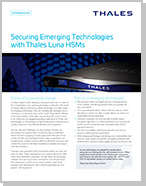
Securing Emerging Technologies with Thales Luna HSMs - Solution Brief
In today's digital world, enterprise and government are in a state of flux. Organizations are optimizing by taking workloads to the cloud, or forging ahead transforming, taking advantage of a wide variety of emerging technologies. They are revisiting their strategies due to...
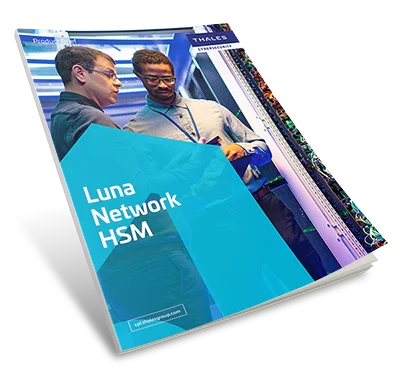
Luna Network HSM - Product Brief
Secure your sensitive data and critical applications by storing, protecting and managing your cryptographic keys in Thales Luna Network Hardware Security Modules (HSMs) - high-assurance, tamper-resistant, network-attached appliances offering market-leading performance and...
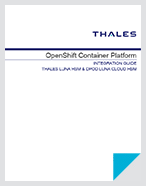
OpenShift Container Platform with Luna HSM and Luna Cloud HSM - Integration Guide
OpenShift Container Platform brings together Docker and Kubernetes, and provides an API to manage these services. OpenShift Container Platform allows you to create and manage containers. Containers are standalone processes that run within their own environment, independent of...

